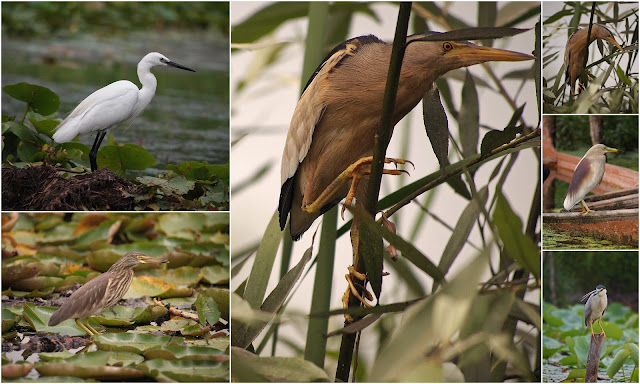Leaving the plains of Haryana, we ventured to Srinagar for a quick visit. Of course, I made it a point to ensure any birding opportunity would be capitalized upon.
Common birds of the area included Streaked Laughingthrush [shown left to right], long-tailed shrike, oriental turtle dove and golden oriole. Of course the laughingthrush is not a thrush at all but an old world babbler. It was seen foraging, keeping fairly low working the shrubbery for insects. The orioles' flutey calls were heard but the birds themselves seldom seen. Another common bird was the Asian Paradise flycatcher with stupendous white tail-plumes. It was seen fluttering around feeding its young which kept hidden in dense thickets.
The male [shown in the center] is a spectacular bird with a black, crested head, blue eye-ring, and flamboyant tail. Other birds seen were the black kite [lower left] and the himalayan bul-bul [upper left]. The shrike was spotted mobbing a domestic cat. The non-stop nagging by the shrike worked and the cat wandered off.
Next stop was Dal Lake for some wetland birds. Target species were common kingfisher, little bittern and black-bellied tern.
The kingfishers were easily seen but a challenge to photograph from the "shikara" [local gondola, hired with 2 oarsmen for about $30]. A bonus kingfisher -- the pied -- was also spotted on a couple of occasions [lower left]. The common kingfisher is extremely photogenic with jewel-like cyan highlights, an oversized dagger of a bill and rufous breast.
Bitterns are reclusive herons and always difficult to find. I did see a few flying low over the lake and had given up hope of finding any cooperative individuals who might want to be photographed. I got lucky when one flew into the reeds close to our gondola.
The little bittern is a larger and less colorful version of our least bittern -- seen here in the center with its large feet holding onto the reed stems. Also seen were Indian Pond Heron [middle right and lower left], black-crowned night heron [same as ours!] and little egret [similar to the Snowy with its yellow feet but larger and darker bill].
The black-bellied tern is an endangered fresh-water tern with a decreasing population. It is considered probably extinct in SE Asia and is thus fast becoming an endemic to the subcontinent. Luckily, at least in Dal Lake, breeding success was observed with several juvenals [center].
The adult tern has a black cap and reddish bill with grey wings contrasting with a black belly. The juvenals appear similar to those of our own black tern. Other birds seen were moorhen [not pictured] and little grebes [lower right].
Unfortunately, most tourists do not come to bird so there isn't much of a birding infrastructure. However, the following resources may prove useful:
Dr. Jehangir Bakshi's website on local birds: Kashmir Birds
Blurb on the Black-Bellied Tern: Birdlife blurb
Map of the area: Dal Lake






No comments:
Post a Comment